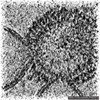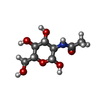+ データを開く
データを開く
- 基本情報
基本情報
| 登録情報 |  | |||||||||
|---|---|---|---|---|---|---|---|---|---|---|
| タイトル | Cryo-EM structure of antibody TJ5-13 bound to H3 COBRA NG2 hemagglutinin | |||||||||
 マップデータ マップデータ | Sharpened map | |||||||||
 試料 試料 |
| |||||||||
 キーワード キーワード | hemagglutinin / antigen / antibody / Fab / VIRAL PROTEIN | |||||||||
| 機能・相同性 |  機能・相同性情報 機能・相同性情報viral budding from plasma membrane / clathrin-dependent endocytosis of virus by host cell / host cell surface receptor binding / fusion of virus membrane with host plasma membrane / fusion of virus membrane with host endosome membrane / viral envelope / virion attachment to host cell / host cell plasma membrane / virion membrane / membrane 類似検索 - 分子機能 | |||||||||
| 生物種 |  Homo sapiens (ヒト) / Homo sapiens (ヒト) /   Influenza A virus (A型インフルエンザウイルス) Influenza A virus (A型インフルエンザウイルス) | |||||||||
| 手法 | 単粒子再構成法 / クライオ電子顕微鏡法 / 解像度: 2.61 Å | |||||||||
 データ登録者 データ登録者 | Dzimianski JV / Cruz JM / Serrao VHB / DuBois RM | |||||||||
| 資金援助 |  米国, 1件 米国, 1件
| |||||||||
 引用 引用 |  ジャーナル: J Virol / 年: 2025 ジャーナル: J Virol / 年: 2025タイトル: Assessing the structural boundaries of broadly reactive antibody interactions with diverse H3 influenza hemagglutinin proteins. 著者: John V Dzimianski / Kaito A Nagashima / Joseph M Cruz / Giuseppe A Sautto / Sara M O'Rourke / Vitor H B Serrão / Ted M Ross / Jarrod J Mousa / Rebecca M DuBois /  要旨: Influenza virus infections are an ongoing seasonal disease burden and a persistent pandemic threat. Formulating successful vaccines remains a challenge due to accumulating mutations in circulating ...Influenza virus infections are an ongoing seasonal disease burden and a persistent pandemic threat. Formulating successful vaccines remains a challenge due to accumulating mutations in circulating strains, necessitating the development of innovative strategies to combat present and future viruses. One promising strategy for attaining greater vaccine effectiveness and longer-lasting protection is the use of computationally optimized broadly reactive antigens (COBRAs). The COBRA approach involves antigen design by generating iterative, layered consensus sequences based on current and historic viruses. Antigens designed by this process show a greater breadth of antibody-mediated protection compared to wild-type antigens, with effectiveness that often extends beyond the sequence design space of the COBRA. In particular, the use of COBRA hemagglutinin (HA) proteins has led to the discovery of broadly reactive antibodies that are suggestive of their therapeutic potential. Understanding the extent to which these antibodies are effective is key to assessing the resilience of vaccine-induced immunity to diverging influenza strains. To investigate this, we tested the binding of broadly reactive antibodies with a diverse panel of H3 HA proteins. Using cryo-electron microscopy, we defined the molecular characteristics of binding for these antibodies at the paratope-epitope interface. Through sequence and structural comparisons, we observed the correlative patterns between antibody affinity and antigen structure. These data shed light on the breadth and limitations of broadly reactive antibody responses in the context of an ever-changing landscape of influenza virus strains, yielding insights into strategies for universal vaccine design.IMPORTANCEFormulating effective influenza vaccines remains a challenge due to a constantly changing landscape of circulating viruses. This is particularly true for H3N2 viruses that undergo a high degree of antigenic drift. Several new vaccine designs can elicit broadly neutralizing antibodies that are effective against a range of influenza strains. More insight is needed, however, into how resilient these antibodies will be to future strains that evolve in the context of this selective pressure. Here, we measured the precise binding characteristics of three broadly neutralizing antibodies to 18 different hemagglutinin (HA) proteins representing almost 50 years of virus evolution. Using single-particle cryo-electron microscopy and X-ray crystallography, we determined the structural characteristics of the epitopes bound by these antibodies and identified specific amino acids that greatly impact the effectiveness of these antibodies. This provides important insights into the longevity of antibody efficacy that can help guide design choices in next-generation vaccines. | |||||||||
| 履歴 |
|
- 構造の表示
構造の表示
| 添付画像 |
|---|
- ダウンロードとリンク
ダウンロードとリンク
-EMDBアーカイブ
| マップデータ |  emd_44305.map.gz emd_44305.map.gz | 217 MB |  EMDBマップデータ形式 EMDBマップデータ形式 | |
|---|---|---|---|---|
| ヘッダ (付随情報) |  emd-44305-v30.xml emd-44305-v30.xml emd-44305.xml emd-44305.xml | 25.6 KB 25.6 KB | 表示 表示 |  EMDBヘッダ EMDBヘッダ |
| FSC (解像度算出) |  emd_44305_fsc.xml emd_44305_fsc.xml | 15.8 KB | 表示 |  FSCデータファイル FSCデータファイル |
| 画像 |  emd_44305.png emd_44305.png | 55.3 KB | ||
| マスクデータ |  emd_44305_msk_1.map emd_44305_msk_1.map | 421.9 MB |  マスクマップ マスクマップ | |
| Filedesc metadata |  emd-44305.cif.gz emd-44305.cif.gz | 7.5 KB | ||
| その他 |  emd_44305_additional_1.map.gz emd_44305_additional_1.map.gz emd_44305_half_map_1.map.gz emd_44305_half_map_1.map.gz emd_44305_half_map_2.map.gz emd_44305_half_map_2.map.gz | 211.3 MB 391.6 MB 391.6 MB | ||
| アーカイブディレクトリ |  http://ftp.pdbj.org/pub/emdb/structures/EMD-44305 http://ftp.pdbj.org/pub/emdb/structures/EMD-44305 ftp://ftp.pdbj.org/pub/emdb/structures/EMD-44305 ftp://ftp.pdbj.org/pub/emdb/structures/EMD-44305 | HTTPS FTP |
-検証レポート
| 文書・要旨 |  emd_44305_validation.pdf.gz emd_44305_validation.pdf.gz | 995.7 KB | 表示 |  EMDB検証レポート EMDB検証レポート |
|---|---|---|---|---|
| 文書・詳細版 |  emd_44305_full_validation.pdf.gz emd_44305_full_validation.pdf.gz | 995.3 KB | 表示 | |
| XML形式データ |  emd_44305_validation.xml.gz emd_44305_validation.xml.gz | 24.2 KB | 表示 | |
| CIF形式データ |  emd_44305_validation.cif.gz emd_44305_validation.cif.gz | 30.7 KB | 表示 | |
| アーカイブディレクトリ |  https://ftp.pdbj.org/pub/emdb/validation_reports/EMD-44305 https://ftp.pdbj.org/pub/emdb/validation_reports/EMD-44305 ftp://ftp.pdbj.org/pub/emdb/validation_reports/EMD-44305 ftp://ftp.pdbj.org/pub/emdb/validation_reports/EMD-44305 | HTTPS FTP |
-関連構造データ
| 関連構造データ |  9b7gMC  9b7hC  9b7iC M: このマップから作成された原子モデル C: 同じ文献を引用 ( |
|---|---|
| 類似構造データ | 類似検索 - 機能・相同性  F&H 検索 F&H 検索 |
- リンク
リンク
| EMDBのページ |  EMDB (EBI/PDBe) / EMDB (EBI/PDBe) /  EMDataResource EMDataResource |
|---|---|
| 「今月の分子」の関連する項目 |
- マップ
マップ
| ファイル |  ダウンロード / ファイル: emd_44305.map.gz / 形式: CCP4 / 大きさ: 421.9 MB / タイプ: IMAGE STORED AS FLOATING POINT NUMBER (4 BYTES) ダウンロード / ファイル: emd_44305.map.gz / 形式: CCP4 / 大きさ: 421.9 MB / タイプ: IMAGE STORED AS FLOATING POINT NUMBER (4 BYTES) | ||||||||||||||||||||||||||||||||||||
|---|---|---|---|---|---|---|---|---|---|---|---|---|---|---|---|---|---|---|---|---|---|---|---|---|---|---|---|---|---|---|---|---|---|---|---|---|---|
| 注釈 | Sharpened map | ||||||||||||||||||||||||||||||||||||
| 投影像・断面図 | 画像のコントロール
画像は Spider により作成 | ||||||||||||||||||||||||||||||||||||
| ボクセルのサイズ | X=Y=Z: 0.835 Å | ||||||||||||||||||||||||||||||||||||
| 密度 |
| ||||||||||||||||||||||||||||||||||||
| 対称性 | 空間群: 1 | ||||||||||||||||||||||||||||||||||||
| 詳細 | EMDB XML:
|
-添付データ
-マスク #1
| ファイル |  emd_44305_msk_1.map emd_44305_msk_1.map | ||||||||||||
|---|---|---|---|---|---|---|---|---|---|---|---|---|---|
| 投影像・断面図 |
| ||||||||||||
| 密度ヒストグラム |
-追加マップ: Unsharpened map
| ファイル | emd_44305_additional_1.map | ||||||||||||
|---|---|---|---|---|---|---|---|---|---|---|---|---|---|
| 注釈 | Unsharpened map | ||||||||||||
| 投影像・断面図 |
| ||||||||||||
| 密度ヒストグラム |
-ハーフマップ: Half map B
| ファイル | emd_44305_half_map_1.map | ||||||||||||
|---|---|---|---|---|---|---|---|---|---|---|---|---|---|
| 注釈 | Half map B | ||||||||||||
| 投影像・断面図 |
| ||||||||||||
| 密度ヒストグラム |
-ハーフマップ: Half map A
| ファイル | emd_44305_half_map_2.map | ||||||||||||
|---|---|---|---|---|---|---|---|---|---|---|---|---|---|
| 注釈 | Half map A | ||||||||||||
| 投影像・断面図 |
| ||||||||||||
| 密度ヒストグラム |
- 試料の構成要素
試料の構成要素
-全体 : A complex of TJ5-13 Fab bound to the H3 COBRA NG2
| 全体 | 名称: A complex of TJ5-13 Fab bound to the H3 COBRA NG2 |
|---|---|
| 要素 |
|
-超分子 #1: A complex of TJ5-13 Fab bound to the H3 COBRA NG2
| 超分子 | 名称: A complex of TJ5-13 Fab bound to the H3 COBRA NG2 / タイプ: complex / ID: 1 / 親要素: 0 / 含まれる分子: #1-#3 |
|---|---|
| 由来(天然) | 生物種:  Homo sapiens (ヒト) Homo sapiens (ヒト) |
-分子 #1: Hemagglutinin
| 分子 | 名称: Hemagglutinin / タイプ: protein_or_peptide / ID: 1 / コピー数: 3 / 光学異性体: LEVO |
|---|---|
| 由来(天然) | 生物種:   Influenza A virus (A型インフルエンザウイルス) Influenza A virus (A型インフルエンザウイルス) |
| 分子量 | 理論値: 62.717137 KDa |
| 組換発現 | 生物種:  |
| 配列 | 文字列: QKIPGNDNST ATLCLGHHAV PNGTIVKTIT NDRIEVTNAT ELVQNSSIGE ICDSPHQILD GENCTLIDAL LGDPQCDGFQ NKKWDLFVE RSKAYSNCYP YDVPDYASLR SLVASSGTLE FKNESFNWTG VTQNGTSSAC IRGSSSSFFS RLNWLTHLNY T YPALNVTM ...文字列: QKIPGNDNST ATLCLGHHAV PNGTIVKTIT NDRIEVTNAT ELVQNSSIGE ICDSPHQILD GENCTLIDAL LGDPQCDGFQ NKKWDLFVE RSKAYSNCYP YDVPDYASLR SLVASSGTLE FKNESFNWTG VTQNGTSSAC IRGSSSSFFS RLNWLTHLNY T YPALNVTM PNNEQFDKLY IWGVHHPGTD KDQIFLYAQS SGRITVSTKR SQQAVIPNIG SRPRIRDIPS RISIYWTIVK PG DILLINS TGNLIAPRGY FKIRSGKSSI MRSDAPIGKC KSECITPNGS IPNDKPFQNV NRITYGACPR YVKQSTLKLA TGM RNVPEK QTRGIFGAIA GFIENGWEGM VDGWYGFRHQ NSEGRGQAAD LKSTQAAIDQ INGKLNRLIG KTNEKFHQIE KEFS EVEGR IQDLEKYVED TKIDLWSYNA ELLVALENQH TIDLTDSEMN KLFEKTKKQL RENAEDMGNG CFKIYHKCDN ACIGS IRNG TYDHNVYRDE ALNNRFQIKG VEGYIPEAPR DGQAYVRKDG EWVLLSTFLG SGLNDIFEAQ KIEWHEGHHH HHH UniProtKB: Hemagglutinin |
-分子 #2: TJ5-13 Fab heavy chain
| 分子 | 名称: TJ5-13 Fab heavy chain / タイプ: protein_or_peptide / ID: 2 / コピー数: 3 / 光学異性体: LEVO |
|---|---|
| 由来(天然) | 生物種:  Homo sapiens (ヒト) Homo sapiens (ヒト) |
| 分子量 | 理論値: 25.796775 KDa |
| 組換発現 | 生物種:  |
| 配列 | 文字列: QVQLVQSGAE VKKPGSSVKV SCEASGDTFT TYSGINWVRQ APGQGLEWMG GVLPNFGSPN YAQRFQGRIT ITVDRSTSLV HMELTNLRS DDTAVYYCTE TGAYNSVGYF PYFQFRGQGT LVSVSSASTK GPSVFPLAPS SKSTSGGTAA LGCLVKDYFP E PVTVSWNS ...文字列: QVQLVQSGAE VKKPGSSVKV SCEASGDTFT TYSGINWVRQ APGQGLEWMG GVLPNFGSPN YAQRFQGRIT ITVDRSTSLV HMELTNLRS DDTAVYYCTE TGAYNSVGYF PYFQFRGQGT LVSVSSASTK GPSVFPLAPS SKSTSGGTAA LGCLVKDYFP E PVTVSWNS GALTSGVHTF PAVLQSSGLY SLSSVVTVPS SSLGTQTYIC NVNHKPSNTK VDKKVEPKSC GSLVPRGSHH HH HH |
-分子 #3: TJ5-13 Fab light chain
| 分子 | 名称: TJ5-13 Fab light chain / タイプ: protein_or_peptide / ID: 3 / コピー数: 3 / 光学異性体: LEVO |
|---|---|
| 由来(天然) | 生物種:  Homo sapiens (ヒト) Homo sapiens (ヒト) |
| 分子量 | 理論値: 22.762055 KDa |
| 組換発現 | 生物種:  |
| 配列 | 文字列: QSVLTQPPSV SGAPGQRVTI SCTGSSSNIG ADYDVHWYQQ LPGTAPKLLI FGNNNRPSGV PDRFSGSKSG TSASLAITGL QAEDEADYY CQSFDKSLSG SFVFGTGTKV TGQPKAAPSV TLFPPSSEEL QANKATLVCL ISDFYPGAVT VAWKADSSPV K AGVETTTP ...文字列: QSVLTQPPSV SGAPGQRVTI SCTGSSSNIG ADYDVHWYQQ LPGTAPKLLI FGNNNRPSGV PDRFSGSKSG TSASLAITGL QAEDEADYY CQSFDKSLSG SFVFGTGTKV TGQPKAAPSV TLFPPSSEEL QANKATLVCL ISDFYPGAVT VAWKADSSPV K AGVETTTP SKQSNNKYAA SSYLSLTPEQ WKSHRSYSCQ VTHEGSTVEK TVAPTECS |
-分子 #8: 2-acetamido-2-deoxy-beta-D-glucopyranose
| 分子 | 名称: 2-acetamido-2-deoxy-beta-D-glucopyranose / タイプ: ligand / ID: 8 / コピー数: 9 / 式: NAG |
|---|---|
| 分子量 | 理論値: 221.208 Da |
| Chemical component information |  ChemComp-NAG: |
-実験情報
-構造解析
| 手法 | クライオ電子顕微鏡法 |
|---|---|
 解析 解析 | 単粒子再構成法 |
| 試料の集合状態 | particle |
- 試料調製
試料調製
| 緩衝液 | pH: 7.5 |
|---|---|
| グリッド | モデル: Quantifoil R1.2/1.3 / 材質: COPPER / メッシュ: 400 |
| 凍結 | 凍結剤: ETHANE / チャンバー内湿度: 100 % / チャンバー内温度: 298 K / 装置: FEI VITROBOT MARK IV |
- 電子顕微鏡法
電子顕微鏡法
| 顕微鏡 | FEI TITAN KRIOS |
|---|---|
| 特殊光学系 | エネルギーフィルター - 名称: GIF Bioquantum / エネルギーフィルター - スリット幅: 20 eV |
| 撮影 | フィルム・検出器のモデル: GATAN K3 BIOQUANTUM (6k x 4k) 撮影したグリッド数: 2 / 実像数: 13223 / 平均電子線量: 45.8 e/Å2 |
| 電子線 | 加速電圧: 300 kV / 電子線源:  FIELD EMISSION GUN FIELD EMISSION GUN |
| 電子光学系 | 照射モード: FLOOD BEAM / 撮影モード: BRIGHT FIELD / 最大 デフォーカス(公称値): 2.1 µm / 最小 デフォーカス(公称値): 0.5 µm |
| 実験機器 |  モデル: Titan Krios / 画像提供: FEI Company |
+ 画像解析
画像解析
-原子モデル構築 1
| 初期モデル |
| ||||||
|---|---|---|---|---|---|---|---|
| 精密化 | 空間: REAL / プロトコル: AB INITIO MODEL / 温度因子: 63 | ||||||
| 得られたモデル |  PDB-9b7g: |
 ムービー
ムービー コントローラー
コントローラー










 Z (Sec.)
Z (Sec.) Y (Row.)
Y (Row.) X (Col.)
X (Col.)





















































